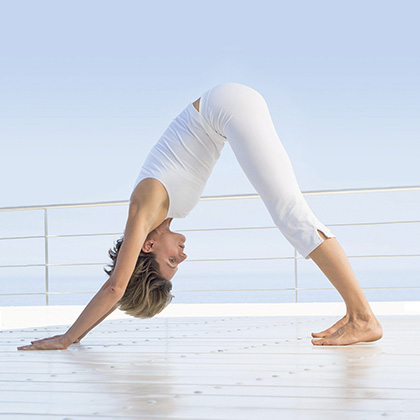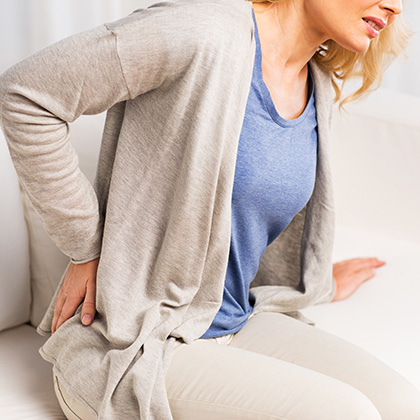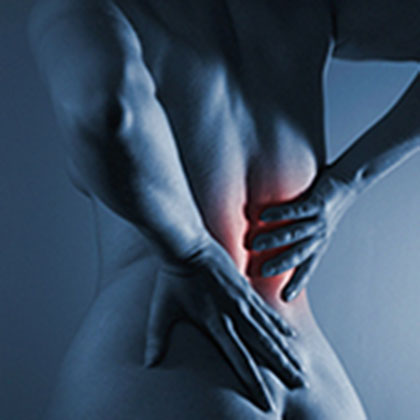
The human body is home to around 160 little fluid-filled sacs called bursae. Each bursa acts as a pressure-relieving cushion between your bones, tendons, joints and muscles, and is lined with synovial cells that produce a lubricant to reduce friction. As a result, your joints, bones, tendons and muscles move easily and smoothly.
But when a bursa is injured or damaged, the tissue inside it becomes inflamed. When that happens the affected area can become painful when you move it or if you put pressure on it. The condition is called bursitis, and it is often caused by joint, muscle or tendon overuse - most notably when you make frequent physical repetitive movements.
As well as pain, symptoms of bursitis can include tenderness (even when you're not moving the affected area), swelling and restricted movement.
What causes it?
The type of repetitive movements that can cause bursitis include excessive walking or running, kneeling, lifting, reaching overhead and bending and straightening the elbow. Over time, these repetitive movements can injure a bursa or bursae near the relevant joints, muscles and/or tendons. In other words, many cases of bursitis tend to develop gradually.
People who play a sport or engage in a physical activity that involves repetitive motions - such as tennis or jogging, for instance - may have a higher risk of developing bursitis. Similarly, those who have jobs that involve kneeling a lot of the time - such as gardeners or carpet layers - are thought to be more likely to develop bursitis in their knees than others.
Bursitis can also be caused by an injury such as a hard blow - caused by a fall, for example - or an infection. The bursae that are most likely to be affected by an infection include those near the elbow plus others that are close to the surface of the skin. Thankfully most healthy people don't develop bursitis as a result of an infection (when bacteria gets into the skin through a cut, for instance, then works its way into a bursa). But those with weakened immune systems may be more susceptible.
If you have bursitis caused by an infection it's called septic bursitis, and you may have additional symptoms including a high temperature. The affected area may also feel hot and look red.
Bursitis can be a complication of another condition too, such as gout, scleroderma or rheumatoid arthritis, where crystals form inside a bursa, making it become irritated and swollen.
According to the US-based Arthritis Foundation, bursitis can also be caused by bad posture or walking habits, as well as stress on soft tissues from an abnormal or badly positioned joint or bone (with joint deformities or leg length differences, to name a couple of examples). It also claims certain medications may cause bursitis as a side effect, and that metabolic conditions such as diabetes can be another cause (i).
Meanwhile it's difficult to say how common bursitis is, as many people who have mild bursitis don't bother seeing their GP about it. Some doctors estimate, however, that bursitis leads to around one in 200 patient visits (ii).
Types of bursitis
Any of the body's 160-odd bursae can become inflamed. However, the following types of bursitis are thought to be the most common:
Prepatellar bursitis
There are four bursae in and around the knee joint, all of which can become inflamed. However the prepatellar bursa, which is directly in front of the kneecap (or patella), is thought to be the one that most often causes bursitis (iii). Also called housemaid's knee, prepatellar bursitis can affect people who spend long periods of time kneeling down.
You can develop prepatellar bursitis at any age - even children can get it, often as the result of an infection that follows a cut or grazed knee. It is, however, more common in men than women (iv). If you have housemaid's knee, your knee will be stiff and you may find it difficult to bend it or kneel on it, or even walk.
Trochanteric bursitis
Often referred to as greater trochanteric pain syndrome (GTPS), this is inflammation of the trochanteric bursa, which is found between the outer side of the hip and the skin. This type of bursitis can be caused by doing an excessive amount of running or walking, or it can happen if you fall heavily on the side of your hip.
Symptoms of trochanteric bursitis include chronic intermittent pain in the outer side of the hip, which sometimes radiates down the outside of the thigh. It can make it difficult for you to sleep well, especially if you like to sleep on the affected side, and you may find the pain gets worse when you're physically active.
According to the National Institute of Health and Care Excellence (NICE), this type of bursitis affects approximately 1.8 - 5.6 people per 1000 per year, with women aged 40 - 60 years old the most likely to be affected (though it can affect younger people, especially runners, footballers and dancers) (v).
Olecranon bursitis
If you fall onto a hard surface and bang the bony part at the back of your elbow, or if you tend to lean a lot on your elbows - on a table while writing or reading, for example - you risk damaging the olecranon bursa, the result of which is bursitis of the elbow. Other causes of olecranon bursitis include having arthritis or an infection of the olecranon bursa (this can happen if you get a cut on your elbow that allows bacteria to get to the bursa under the skin). Many cases also have no apparent reason, though doctors think these may be related to injuries that people aren't aware of or have forgotten. Experts believe this type of bursitis most commonly affects men aged between 30 and 60.
Experts believe this type of bursitis most commonly affects young and middle-aged men; athletes who play certain sports (gymnastics, weightlifting, rugby, football and hockey, for instance); as well as people with jobs that involve the risk of elbow trauma such as gardeners, carpet layers, mechanics, plumbers, roofers, truck drives and those who write on a regular basis (vi).
Subacromial-subdeltoid bursitis
The largest bursa in the body, called the subacromial-subdeltoid bursa, is found in the shoulder joint. Its role is to protect and help the rotator cuff tendons move smoothly when you move your arm in an upwards and downwards motion.
If you have shoulder pain in either side when you lie down or while resting, when you raise your arm or when lifting heavy objects (in which case the pain may be severe), accompanied by swelling and tenderness in the shoulder area, there's a good chance you've injured your shoulder bursa. Various things can cause this injury, including repetitive lifting or reaching movements, falling hard on your shoulder, general wear and tear of the shoulder joint and an underlying inflammatory condition such as arthritis.
Retrocalcaneal bursitis
The retrocalcaneal bursa is found in the heel, between the Achilles tendon and the heel bone. This can become injured if you do a lot of walking - particularly uphill - or stepping/stair climbing, running or jumping. Some experts also believe wearing very tight shoes can damage the retrocalcaneal bursa.
Other things that may contribute to the development of retrocalcaneal bursitis include having tight or weak calf muscles, not warming up before exercising, excessive exercising and having a foot problem such as flat feet. Symptoms include pain, tenderness and swelling in the ankle and Achilles area.
Treatments for bursitis
Mild cases of bursitis can be treated at home by using self-care techniques and taking over-the-counter painkillers. Expect the pain to gradually improve over the course of a few weeks - exactly how long depends on the type of bursitis and whether or not it's the result of an infection - though you may notice the swelling stays around for a while longer.
Rest up
Try to avoid activities - especially strenuous ones - that put any further pressure on the affected joint, bone, tendon or muscle until it's feeling better. Try to avoid long periods of standing if your knees, ankles or hips are affected. And when you go to bed, try not to lie on the part of your body that's tender. Depending on where your bursitis is, you may also want to use a sling, brace or splint to make it easier for the area in question to rest. You could also use knee pads to protect against further injury if you have bursitis in the knee.
Reduce pain
Over-the-counter painkillers such as paracetamol can provide pain relief while anti-inflammatory painkillers such as ibuprofen help tackle inflammation. Ibuprofen isn't suitable for everyone, so check with the patient information leaflet inside the packet before you take a dose. If you need stronger painkillers, you'll need a prescription from your GP.
Chill out
Use an ice pack on the affected area to help reduce inflammation and pain. You can make your own by wrapping ice cubes or a bag of frozen vegetables in a towel - however, never apply ice directly to your skin. Place the ice pack on the affected area for around 10 minutes every few hours.
Seek professional help
If you have bursitis symptoms that don't improve after two weeks of using self-care techniques, the NHS claims you should see your GP (however, if you have the symptoms of bursitis accompanied by a high temperature, see your doctor straight away as you may have septic bursitis) (vii).
Your doctor may recommend steroid injections to help reduce the inflammation, or you may be advised to have the fluid drained out of the affected area with a needle if the swelling is particularly bad (this is called aspiration). Meanwhile if you have septic bursitis, your GP will usually prescribe antibiotics to treat the infection. If the affected bursa doesn't respond to the treatment, you may be recommended to have surgery to remove it – though this only happens rarely.
Preventing bursitis
Whether you've had bursitis in the past or not, there are several things you can do to reduce your risk of developing another - or your first - episode:
Take regular breaks
If you're doing something that involves repetitive movements, aim to take plenty of breaks to avoid overusing particular joints and muscles. Also try to vary what you do or how you do it at regular intervals, as this may help avoid putting too much strain on a certain body part.
Pad up
Use things that can help protect parts of your body that may be susceptible to damage because of the movements you do regularly. If you're a keen gardener, for instance, invest in some knee pads to protect your knees. Sports supports can also protect your knees, ankles and elbows.
Meanwhile if you do a lot of running or walking, wear good shoes or trainers that support your joints and muscles. If you're not sure which trainers to wear for running or jogging, consider buying a pair from a specialist running shop, where you can get lots of advice on which trainers would suit you best. A podiatrist may also be able to advise you about looking after your feet and which shoes you should wear.
Build up your muscles
If you've had bursitis previously, you may be able to reduce your risk of it coming back again if you strengthen the muscles around the joint that was affected. You may want to consider consulting a physiotherapist or fitness trainer to learn about the exercises you should do to strengthen specific muscles. Here are a couple of examples:
Thigh muscle strengthener
This is called a quad set and it's often recommended for knee bursitis prevention. Sit on the floor with the affected leg straight in front of you and the other leg bent. Then press the back of the knee of the outstretched leg against the floor by tightening the muscles on the top of your thigh (quadriceps). Place a rolled-up towel under your knee if that helps. Hold for 10 seconds, then repeat 10 times.
Clamshells
You may find this useful for stabilising and strengthening some of the muscles on the outside of your hips. Lie on your side with the affected hip on top and bend both knees forward slightly, supporting your head with the hand of the arm nearest the floor. Place the hand of the upper arm on the floor in front of your torso to help keep you stable. Keeping your feet together, lift your top knee until it's about eight or 10 inches from the bottom knee. Don't let your top hip roll back, and hold in this position for 10 seconds. Lower your knee back to the starting position and repeat 10 times.
Note: only perform strengthening exercises after you've recovered fully from an episode of bursitis.
Warm up
It's also a good idea to warm up your muscles for up to 10 minutes before taking part in any vigorous physical activity. Try warm-up exercises such as marching on the spot, knee raises, shoulder raises and knee bends. Or if you're going for a run or a jog, have a brisk 10-minute walk beforehand. It's also advisable to stretch your muscles after exercising.
Natural remedies for bursitis
Resting, using ice packs and taking over-the-counter painkillers are all recommended by conventional health professionals ways of treating mild cases of bursitis. There are, however, no natural treatments specifically for this condition that have any solid scientific support. But it may be useful to take a natural supplement that may help reduce the inflammation that causes swelling in bursitis, such as turmeric and fish oils.
Turmeric
Curry fans will be familiar with the colour and taste of turmeric, which is a member of the Zingiberaceae plant family. This spice is also widely used in the Indian system of herbal medicine known as Ayurveda and is often recommended for conditions that include inflammation.
There is also some evidence that turmeric may have painkilling capabilities, as one study suggests Zingiberacae extracts are clinically effective hypoalgesic agents (that is, they treat pain effectively) - but without the side effects associated with conventional painkillers such as non-steroidal anti-inflammatory drugs (NSAIDs) (viii).
Fish oils
High-strength fish oil supplements contain good levels of the omega-3 essential acids EPA (eicosapentaenoic acid) and DHA (docosahexaenoic acid), which have also been shown to help reduce inflammation (ix). As well as fish oil supplements you can find EPA and DHA in oily fish, such as salmon, sardines, pilchards, mackerel, herring and fresh tuna.
If you’re a vegetarian or vegan you can still benefit from an omega-3 supplement, thanks to the availability of products that contain the natural triglyceride (TG) form of omega-3, which is sourced from plant organisms called microalgae rather than fish oils.
PEA
Also known as palmitoylethanolamide, PEA is a type of fatty acid made naturally by the body and found in all cells, tissues and fluids including the brain (it’s also found in foods such as soya beans, peanuts, eggs, flaxseed and milk). Described as an endocannbinoid-like chemical that belongs to a family of fatty acid compounds called amides (x), PEA is an alternative to CBD, since both substances are thought to have similar properties including the ability to reduce pain and inflammation. However researchers suggest PEA is safer than CBD, since it has been studied more extensively and has a more robust safety profile (xi) with no known side effects (x).
Your body naturally increases its production of PEA when your cells are damaged or threatened. But in certain situations – such as when your body is experiencing chronic inflammation – the level of PEA in your cells drops (x). When this happens, PEA supplements may be helpful. In fact a review of 16 clinical trials and meta-analysis of PEA suggests it does have analgesic actions – in other words it helps to relieve pain (xii).
To discover more information on a range of other health concerns, feel free to visit our dedicated health library.
References:
-
Available online: https://www.arthritis.org/about-arthritis/types/bursitis/
-
Available online: https://www.netdoctor.co.uk/conditions/aches-and-pains/a2862/bursitis/
-
Available online: https://patient.info/doctor/prepatellar-bursitis
-
Available online: https://patient.info/bones-joints-muscles/knee-pain-patellofemoral-pain/housemaids-knee-prepatellar-bursitis
-
Available online: https://cks.nice.org.uk/greater-trochanteric-pain-syndrome-trochanteric-bursitis#!backgroundSub:3
-
Available online: https://cks.nice.org.uk/olecranon-bursitis#!backgroundSub:2
-
Available online: https://www.nhs.uk/conditions/bursitis/
-
Lakhan. SE, Ford. CT, Tepper. D. Zingiberaceae extracts for pain: a systematic review and meta-analysis. Nutr J. 2015 May 14;14:50.
-
Simopoulos. AP. Omega-3 fatty acids in inflammation and autoimmune disease. J AM Coll Nutr. 2002 Dec;21(6):495-505.
-
Maroon. JC., Bost W., Omega-3 fatty acids (fish oil) as an anti-inflammatory: an alternative to nonsteroidal anti-inflammatory drugs for discogenic pain. Surg Neurol. 2006 Apr;65(4):326-31.
-
Clayton P. et al., Palmitoylethanolamide: A Natural Compound for Health Management. Int J Mol Sci. 2021 May;22(10): 5305. Available online: https://www.ncbi.nlm.nih.gov/pmc/articles/PMC8157570/
-
Clayton P. et al., Palmitoylethanolamide: A Potential Alternative to Cannabidiol. J Diet Suppl. 2021 Nov;28;1-26. Available online: https://www.tandfonline.com/doi/full/10.1080/19390211.2021.2005733
-
Gabrielsson . L, Mattsson. S, Fowler. CJ. Palmitoylethanolamide for the treatment of pain: pharmacokinetics, safety and efficacy. Br J Clin Pharmacol. 2003;110:359-362.Available online: https://www.ncbi.nlm.nih.gov/pmc/articles/PMC5094513/
Related Posts
Disclaimer: The information presented by Nature's Best is for informational purposes only. It is based on scientific studies (human, animal, or in vitro), clinical experience, or traditional usage as cited in each article. The results reported may not necessarily occur in all individuals. Self-treatment is not recommended for life-threatening conditions that require medical treatment under a doctor's care. For many of the conditions discussed, treatment with prescription or over the counter medication is also available. Consult your doctor, practitioner, and/or pharmacist for any health problem and before using any supplements or before making any changes in prescribed medications.

Christine
Christine Morgan has been a freelance health and wellbeing journalist for almost 20 years, having written for numerous publications including the Daily Mirror, S Magazine, Top Sante, Healthy, Woman & Home, Zest, Allergy, Healthy Times and Pregnancy & Birth; she has also edited several titles such as Women’ Health, Shine’s Real Health & Beauty and All About Health.
View More



